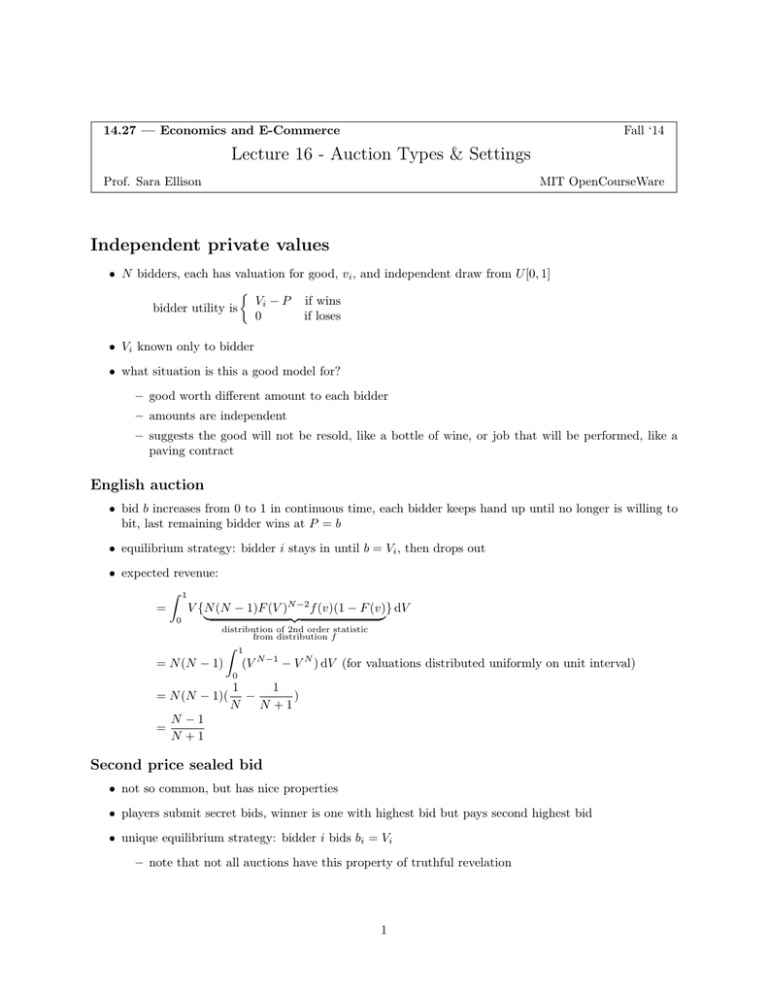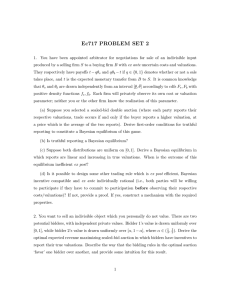Lecture 16 - Auction Types & Settings
advertisement

14.27 — Economics and E-Commerce
Fall ‘14
Lecture 16 - Auction Types & Settings
Prof. Sara Ellison
MIT OpenCourseWare
Independent private values
• N bidders, each has valuation for good, vi , and independent draw from U [0, 1]
Vi − P
0
bidder utility is
if wins
if loses
• Vi known only to bidder
• what situation is this a good model for?
– good worth different amount to each bidder
– amounts are independent
– suggests the good will not be resold, like a bottle of wine, or job that will be performed, like a
paving contract
English auction
• bid b increases from 0 to 1 in continuous time, each bidder keeps hand up until no longer is willing to
bit, last remaining bidder wins at P = b
• equilibrium strategy: bidder i stays in until b = Vi , then drops out
• expected revenue:
1
V {N (N − 1)F (V )N −2 f (v)(1 − F (v)} dV
=
0
distribution of 2nd order statistic
from distribution f
1
(V N −1 − V N ) dV (for valuations distributed uniformly on unit interval)
= N (N − 1)
0
1
1
= N (N − 1)( −
)
N
N + 1
N − 1
=
N +1
Second price sealed bid
• not so common, but has nice properties
• players submit secret bids, winner is one with highest bid but pays second highest bid
• unique equilibrium strategy: bidder i bids bi = Vi
– note that not all auctions have this property of truthful revelation
1
Lecture 16
Auction types & settings
14.27, Fall ‘14
• proof:
– if switch to b�i > Vi , payoff changes only if they lose at Vi and win at b�i , but that’s bad because
then you win and pay more than your valuation
– if switch to b�i < Vi , payoff changes only if you win at Vi and lose at b�i , but that’s bad because
you would have been willing to pay more to win
• expected revenue:
N −1
N +1
First price sealed bid auction
• very common for government auctions
• same as second price sealed bid, but bidders pay their bid –do you think the equilibrium bidding
strategy will be the same?
• can’t be, really, since what you pay if you win is different
• unique equilibrium strategy: bidder i bids Bi =
N −1
N Vi
• no proof but intuition: bidders shade bids down, trading off bidder surplus if they win vs chance of
losing, makes sense that shading would be function of N
• expected revenue:
N −1
N +1
• note: bidders shading down ends up exactly canceling out effect of paying top bid instead of second
highest
Dutch auction
• like English auction, but with b decreasing from 1 to 0
• bidders raise their hand as soon as they’re willing to bid and the auction ends when a hand is raised
• equilibrium strategy and expected revenue: same as in first price sealed bid
Revenue equivalence
• N -bidder IPV setting with evaluations Vi F on [v, v̄]
• if object must be sold (no reserve) and all bidders must receive non-negative surplus (participation
constraint), then any auction satisfying the following properties maximizes the seller’s expected revenue:
– in equilibrium, the winning bidder is the highest valuation bidder
– the v type gets zero expected surplus
– this rules out crazy or random auctions
• first price, second price, English, and Dutch auctions are all revenue equivalent
Exceptions to revenue equivalence
• sellers can often do better by setting and announcing a reservation price
• if bidders are risk-adverse, first price auction is better for the seller than second price
– intuition: revenue from second price is unchanged and still bi = Vi
– people shade bids down less in first price than they normally would because they’re afraid of losing
(increasing bid by and reduces surplus in states where utility is less steep and increases in states
where utility is steeper)
2
Lecture 16
Auction types & settings
14.27, Fall ‘14
Common values
• N bidders, good has value V to winner of auction
• no one observes V but every bidder receives some information Si (“signal”) about V
e.g., Si = V + Ei where know V ∼ N (0, 1) and Ei ∼ N (0, σ)
• using Bayes rule, every bidder can calculate E(V |Si ) = Wi =
1
1+σ 2 Si
Second price sealed bid auction
• do not want to bid Wi
• why? remember everyone has independent information about the value of the good –if you win by
bidding your best guess of its value based upon your information, the fact that you won is bad news
about the value
• this is what’s known as the “winner’s curse” (could be more accurate translation of caveat emptor than
“buyer beware”)
• note: in equilibrium, bidders should shade bids down to take winner’s curse into account
• other auction mechanisms? shade value to account for adverse selection.
In reality
• most auctions have some private value and some common value character to them:
– e.g., Van Gogh painting –I will enjoy seeing it on my wall but I also care about the prestige
associated with owning it and the resale value if I want to eventually sell it.
– e.g., I’m bidding on a highway paving contract –there is relevant information for me in my rivals’
bids because we’re all just estimating how much it’s going to cost, but I have a cost advantage
because I’m currently working on a job close by.
– e.g., timber tract –impossible to count exact number and types of trees, but can “cruise” tract to
estimate (knowing the market value of milled timber). however, my mill is currently running at
capacity and my loggers are busy so I wouldn’t be able to log the tract for several months.
Empirical studies of auctions
• lab & field experiments
– e.g., auction off identical items repeated withed posted reserve, secret reserve, no reserve and see
how you do
– lab: pay undergrads to sit in special labs and bid on made-up goods
– field: set up actual auctions to conduct experiments
– what if we change auction mechanisms –do we make more money? should I set a reserve price?
– of more academic value, testing validity of theory
• “reduced form”
– suggests a theory, derives equilibrium predictions in that theory, sees whether predictions are
borne out in reality.
3
Lecture 16
Auction types & settings
14.27, Fall ‘14
– e.g., revenue for identical items should be greater in English than in second price if valuations are
positively correlated because information revelation leads to more intense competition.
• “structural”
– assumes a theory, uses that theory to back out primitives that are not observable with primitives
– can run “counterfactuals”, such as what auction mechanism maximizes revenue but relies on theory
being correct
– e.g., 1st price sealed bid auction where you know N –if you have data on all bids Bi can back out
valuations Vi and then run counterfactuals
Edelman, Ostrovsky, Schwartz
• first paper to study the type of auction that Google runs for sponsored search –called it a “position
auction”
• even though it’s a generalized second price auction, they showed that it is not a “truth-telling mecha­
nism”
• in other words, it is not optimal for bidders to bid their valuations (this is because Google is auctioning
off several positions at once)
– e.g., 3 bidders and 2 positions
– valuations are V1 = 10, V2 = 9, and V3 = 2
– positions have the following clicks: P1 = 200 and P2 = 199
– truthtelling: π1 = 200(10 − 9) = 200
– if 1 bids below 2: π1 = 199(10 − 2) = 1592
– still achieves efficient allocation, max revenue
• there have been additional papers studying this auction design
• sidenote: Bing, Yahoo, Google have recently changed the way they label sponsored search, more often
using the term “ad” or “advertising” or “paid advertising”, partly due to research from Ben Edelman
showing that consumers didn’t know what sponsored search was.
4
MIT OpenCourseWare
http://ocw.mit.edu
14.27 Economics and E-Commerce
Fall 2014
For information about citing these materials or our Terms of Use, visit: http://ocw.mit.edu/terms.




